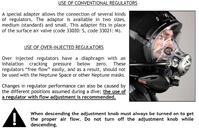... And I have no idea why you say they can't be used on high O2 mixes. I used my OC setup with 100% for deco all the time...
WARNING, Dangerous Practice:
Rapid-opening valves generate high flow velocities that are sufficient to heat tiny particles glowing red, which is really dangerous on pure oxygen. NASA did tons of studies after the Apollo capsule fire. One study filmed the phenomenon with high-speed cameras. Fortunately, ball valves had not been very reliable with high pressure gases for very long at that point so the number of oxygen systems using them was pretty small.
Most "non-combustible" materials burn like crazy in high pressure pure O2 environments. Oxygen fires are really violent explosions that degrade into a raging fires as the pressure diminishes and Oxygen is diluted.
Causes of Ignition in Oxygen Regulators 2001 - YouTube
Some rapid-acting valves are acceptable at low pressures that vent to atmosphere like solenoid valves that add oxygen to a chamber or breathing loop because the velocity is low, pressure drops instantly, and the O2 level drops from dilution.
Unfortunately, the UDT/SEAL base at Coronado was one of the known fires. I was assigned to Submarine Development Group One's Mark II Deep Dive System in the early 1970s when the explosion occurred. We had one of the first clean rooms for Oxygen systems in the Navy so we had been trained in the latest research. A team was asked to help investigate and found that ¼" ball valves were used on the cascade panel used to charge the Oxygen CCR cylinders. The final report clearly stated that ball valves were the cause of the disaster.
Nobody has done the research necessary to quantify where the safe thresholds are; which would also depend on system cleanliness, pressure differentials, and oxygen level of the gas. Other than pure Oxygen, O2 mixes above 21% are rarely used in saturation diving. Therefore the lack of guidelines on how rich a mix we could use with ball valves wasn't a concern.
The accepted safe practice in the industrial gas industry is "no ball valves on Oxygen systems" and is prudent to follow until we know a great deal more.
Edit: Oxygen Safety for Haskel Booster Users. See page 3
Last edited:




